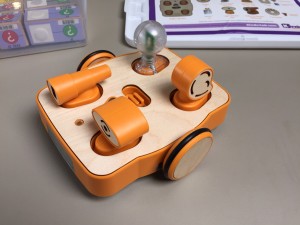KIBO, from KinderLab Robotics, is a clever merger of hands-on building with basic computer science. KIBO grew out of a research program at Tufts’ DevTech Research Group, where it was called KIWI. KIBO is small wheeled robot with a few sensors which kids snap together (and can further decorate). Kids program KIBO by building a linear program out of physical wooden command blocks Scratch blocks and then scanning the barcodes on those blocks with their KIBO unit. The whole process happens without any screens involved.
The block language consists of movement blocks (move, turn, spin) and sensor reporting blocks (light/dark, near/far), along with control structures (conditionals and loops), which enable some pretty sophisticated CS concepts to be introduced. Programming KIBO feels a lot like programming in ScratchJr. The target age range for KIBO (4 – 7) is similar to ScratchJr as well.

The ability to decorate the robot introduces a great art/craft aspect as well. The Tufts DevTech folks have a nice video about a curriculum unit using the robot to support studies of dances in different cultures. KIBO hits a lot of great notes for me: STE(A)M, play, physical representation of programming. I look forward to experimenting with it more!